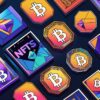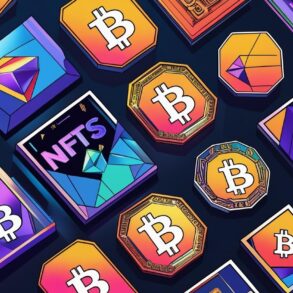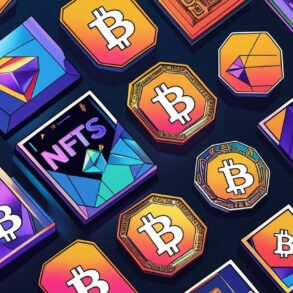
With NFTs, your digital word is your digital bond.
© peshkova/stock.adobe.com
Have you ever thought about buying a non-fungible token—an NFT? If you aren’t terribly interested in owning digital art, then you may think NFTs just aren’t for you. But did you know that NFTs can be used to digitally establish ownership of almost anything? A non-fungible token uses a smart contract on a blockchain to enable many different types of transactions.
The list of potential use cases for NFTs is long and wide-ranging. Here are eight ways that NFTs can be used today—theoretically, anyway, as most have yet to see widespread adoption.
1. Own digital collectibles
NFTs are best known for signifying ownership of digital collectibles like graphic art and gaming assets. The creator of a digital collectible can “tokenize” the asset by minting an NFT—that is, using a blockchain platform to create a unique token associated with the asset.
Digital collectibles that can be tokenized using NFTs include:
- Digital art
- Digital comic books
- Music and music videos
- Digital trading cards
- Gaming avatars
- Virtual clothing and accessories
- Virtual pets
- Digital real estate
Platforms like OpenSea and Rarible support marketplaces for tokenized digital collectibles. CryptoPunks and Bored Ape Yacht Club produce tokenized art that’s among the most recognized, while CryptoKitties is a popular NFT-based game with virtual cats. Several metaverse platforms—including Decentraland, The Sandbox, and Axie Infinity—support the purchase and ownership of digital real estate.
2. Collect fine art
A non-fungible token can be used to indicate ownership of fine art. Any physical work of art can be tokenized by creating an NFT associated with the artwork. The smart contract underlying the NFT is programmed to contain a wealth of information about the art, including its creator, current owner, and provenance (the documented history of an artwork’s origin, custody, and locations).
In recent years, brokerage firms began offering fractional shares of stock. Did you know that NFTs can also be used to “fractionalize” the ownership of physical art, meaning you can partially own an individual piece of art? An expensive piece of art can be tokenized into many NFTs, with each NFT representing partial ownership of the asset. Tokenizing can make it possible to invest in fine art with a limited budget. The only catch is that you don’t physically possess the creative work.
Masterworks, Maecenas, and ArtSquare.io are all platforms that tokenize fine art into NFTs for fractional ownership.
3. Buy a home
A non-fungible token can potentially be used to establish home ownership. A person selling a home can create an NFT that represents ownership of the home, and may transfer that NFT to the buyer when all required conditions are met. Tokenizing a home’s ownership can enable home-buying transactions that are transparent, secure, and efficient.
Propy is an example of a platform that supports decentralized title registries. The platform uses blockchain technology to track the full life cycles of real estate and title records.
4. Fractionally invest in real assets
Just as NFTs can enable fractional investing in fine art, investors can use non-fungible tokens to own fractions of real assets. Real estate and luxury assets like yachts and private jets can all be tokenized into ownership fractions using NFTs.
Fractional investing in real assets is appealing to many investors because it can provide the benefits typically associated with this asset class—without the hefty price tag. Investors can diversify their real asset portfolios by investing in a wide variety of assets. NFTs also enable fractional ownership interests to be traded and sold via digital platforms.
Several platforms support the fractional ownership of real assets. RealT tokenizes residential real estate, while Salient Yachts mints NFTs for fractional yacht ownership.
5. Buy a car
Do you enjoy time-consuming errands like registering your car? If not, you may be pleased to hear that non-fungible tokens can potentially be associated with specific vehicles to establish car ownership.
Goodbye, paper titles? Maybe, but not just yet. Plenty of regulatory hurdles stand in the way before drivers can use NFTs to prove car ownership. Companies like CarForCoin already offer NFTs—in addition to paper titles—to establish ownership of luxury vehicles.
6. Get insurance
NFTs may also change the way you get insurance. Your customized insurance policy, with all of its terms and conditions, can be tokenized and published to a blockchain.
Blockchain technology can increase the transparency of claims processes and create opportunities for anyone in a blockchain network—not just large corporations—to offer insurance. NFTs can also enable insurance policies to be bought, sold, and traded.
Platforms like Etherisc already let anyone create an insurance product. Blockchain-based insurance is available for flight delays, hurricanes, crop protection, and more. But insurance is another highly regulated industry, meaning that current rules would likely need to evolve before legacy insurance providers can rely on NFTs.
7. Borrow money
Non-fungible tokens can represent debt. A loan agreement—even a home mortgage—can be tokenized as an NFT and published to a blockchain. Assets already tokenized by NFTs, such as digital art, can also collateralize debt.
Brightvine is a platform that is tokenizing mortgages for investors to buy, sell, and trade. Several other platforms, including NFTfi, Pine.loans, and Zharta, enable users to borrow money by leveraging NFTs they already own as collateral.
8. Earn reward tokens
Companies can use NFTs to offer unique rewards to their customers. An NFT can grant special access or privileges, transfer ownership of a rare digital collectible, or create a personalized digital experience. Rewards that are tokenized into NFTs may also be traded or sold.
Major corporations like Taco Bell are experimenting with NFTs to boost customer loyalty. In 2019, Nike secured a patent for “Cryptokicks” to pair non-fungible tokens with physical shoe releases. And tech companies like Venly can mint NFTs for small businesses wishing to create customized rewards programs.
The bottom line
Non-fungible tokens are technology on the forefront of innovation. The ability of NFTs to place value on even intangible assets means that they may radically change how ownership is assigned and value is distributed.
But if you don’t want to own a digital collectible, then don’t buy one—regardless of whether the collectible is tokenized. And remember that using non-fungible tokens is risky. NFT users can have unexpected outcomes precisely because the technology is still emerging and under development—it’s both innovative and new. Do your own research to stay informed about the risks and benefits of non-fungible tokens.
Specific companies are mentioned in this article for educational purposes only and not as an endorsement.
This post was originally published on this site be sure to check out more of their content







